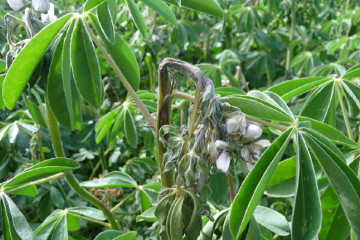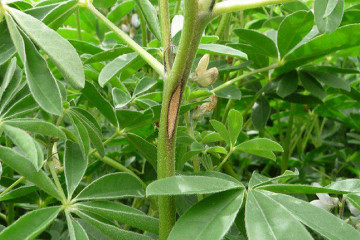Australian Pulse Bulletin
Lupin fungicide guide: 2022 season
Lupins are affected by several foliar fungus diseases, Lupin anthracnose (LA), Sclerotinia stem rot (SSR), Phomopsis (Diaporthe toxica) (P), Brown spot (Pleiochaeta setosa) (BS) and Botrytis grey mould (BGM). DIseases are best managed by using resistant varieties (LA, P, BS), rotating paddocks to non-host crops (BS, SSR, P), fungicide seed dressings (LA, BS) or occasionally foliar fungicides (LA, SSR, BGM).
Lupin anthracnose is a serious fungal disease that has been found in several regions around Australia. and has been endemic in WA since the mid 1990’s. Most recently southern NSW crops were found with the disease in 2016, but surveillance in 2017-18 across NSW showed no signs of the disease, and the restrictions were lifted to allow Albus lupins to be grown again across the region. There have been no recordings of this disease in SA since 2005, and it has not been found in commercial lupin crops in Victoria. It is an exotic disease to NSW and Vic and should be reported to the exotic pest hotline if suspected. It is strongly recommended that farmers and agronomists be vigilant in keeping a close watch on lupin crops when the seasonal conditions favour this disease, such as we have in 2021. NSW DPI have more information on their website and if suspected should be reported to Exotic Plant Pest Hotline 1800 084 881
Pulse Australia have Minor Use Permits from APVMA to help growers manage LA and SSR disease in lupin crops, and these are shown in the table below along with all the currently registered products.
Foliar fungicide applications to lupin crops is only necessary under high disease pressure conditions. Decisions need to be made such as assessing the disease risk to the crop and likelihood of economic returns from a fungicide application, when to start the spray program and how often to spray, depending on the varietal resistance, the prevailing weather conditions and the potential yield of the crop.
Fungal disease control is based on protection of healthy plants rather than curing infections. The first fungicide application may be applied as early as necessary to minimise the establishment of the disease. Additional sprays may be required if the weather conditions favour disease development.
Fungicides remain effective for approximately 10-14 days, but keep in mind that all new growth after spraying is unprotected.
The need for repeated fungicide applications depends on the growth stage of the crop, the time since the last fungicide application and the likelihood of further conditions favouring disease development. Unprotected crops may be quickly defoliated and destroyed by the infection. The choice of fungicide is less important than the timing, but when multiple sprays are required during the season it is critical to rotate different products and modes of action to preserve the effectiveness of all the fungicide choices. Follow this link for advice on maintaining fungicide efficacy for the grain industry.
Seasonal Conditions in 2022
After several good seasons in 2020 and 2021 that produced record yields in many areas of Australia, rainfall has been variable over summer in many regions. NSW and Queensland have had good rainfall over summer that has given full soil moisture profiles (some paddocks waterlogged). South Australia started with dry conditions for sowing winter crops but have recently received adequate rain to get crops germinated. Victoria had early plant establishment with warm soils and good soil- moisture in most areas, resulting in a higher disease risk. In Western Australia conditions have been very favourable for sowing crops and regular rain events have followed. This season will be favourable for many diseases as we head into spring. Many of these diseases need only limited moisture to infect crops (heavy dew or fog provides enough moisture), so monitoring needs to be continued throughout the season. Later in the season after canopy closure, higher water rates will aid in canopy penetration. Timely fungicide applications ahead of rain events will give the crop the best chance of a high yield. Susceptible crops need continuing fungicide protection for good pod fill so timely application of fungicides by ground sprayers will give the spray coverage required. Growers are recommended to rotate and mix fungicides from different group to minimise the risk of fungicide resistance developing in the pathogen populations.
Pulse Australia acknowledges the input of the state government pathologists in the preparation of this seasonal guide : Kurt Lindbeck (NSW DPI), Sara Blake (SARDI), Josh Fanning (Vic DPI), Geoff Thomas (WA DPIRD).
For more detailed information on disease management:
- Lupin best management guide
- CropPro lupin disease manual
- Fungicide resistance in grain crops (including pulses)
Minor Use Permits for fungicide on lupins
- PER82209 Chlorothalonil / Albus lupin / Anthracnose / Current to 30-June-2026 (NSW and WA)
- PER82240 Boscalid / Narrow-Leaf Lupins & Albus Lupins / Sclerotinia Stem Rot (White Mould) / Current to 30-Sep-2023 (WA only)
-
PER82226 Amistar / Lupins / Anthracnose / Current to 31-Oct-2024
Fungicides registered for disease control in lupins
| Lupin Foliar Fungicide
|
Trade Name example
|
Anthracnose
|
Botrytis grey mould
|
Sclerotinia
|
WHP Harvest
|
|---|---|---|---|---|---|
| Chlorothalonil (M5)
|
Bravo 500
|
Permit 2.0 L/ha
|
NR
|
NR
|
14 days
|
|
|
Bravo 720
|
Permit 1.5 L/ha
|
NR
|
NR
|
14 days
|
|
|
Mueso 900
|
Permit 1.1 L/ha
|
NR
|
NR
|
14 days
|
| Mancozeb 750 (M3)
|
Dithane DF
|
1.0 to 2.2 kg/ha
|
1.0 to 2.2 kg/ha
|
NR
|
28 days
|
| Boscalid 500 (Group 7)
|
Filan
|
NR
|
NR
|
Permit 0.4 to 1.0 kg/ha (WA only)
|
21 days
|
| Azoxystrobin 250 (Group 11)
|
Amistar
|
Permit 500 mL/ha | NR | NR
|
28 days
|
Many of the Minor Use Permits have short term expiry dates (e.g. 30/11/2022)
NR = Not Registered for this disease
Read the LabelAs with any chemical application, care should be taken to observe all the label conditions for each product. Some label advice is different for each state or region, so for best results, it is important that this is followed. Many of our pulse crops are exported for human consumption, so market access is dependent on having the product free of chemical residues. Australian has a reputation for providing clean and safe produce so it is vital that this is maintained by using chemicals according to regulations. All permits have label recommendations for use rate and withholding periods (WHP) that must be observed so grain will comply with Maximum Residue Limits (MRL) allowable for market access. |
Key contacts
Pulse Australia Industry Development Managers
- Paul McIntosh
Phone: 0429 566 198 - Phil Bowden
Phone: 0427 201 946
Support and funding acknowledgement
Disclaimer
Information provided in this guide was correct at the time of the date shown below. No responsibility is accepted by Pulse Australia for any commercial outcomes from the use of information contained in this guide.
The information herein has been obtained from sources considered reliable but its accuracy and completeness cannot be guaranteed. No liability or responsibility is accepted for any errors or for any negligence, omissions in the contents, default or lack of care for any loss or damage whatsoever that may arise from actions based on any material contained in this publication.
Readers who act on this information do so at their own risk.
Copyright © 2015 Pulse Australia
All rights reserved. The information provided in the publication may not be reproduced in part or in full, in any form whatsoever, without the prior written consent of Pulse Australia. www.pulseaus.com.au
Last updated: 26 July 2022



